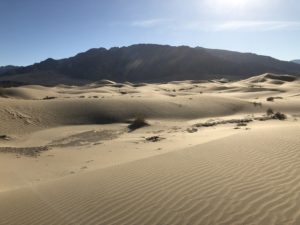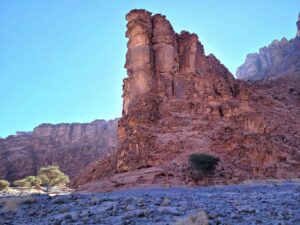In late 2015, when I (Roland Banas) read on the Adventure Blog that Louis-Philippe Loncke had claimed the first solo unsupported crossing of Death Valley (USA), two thoughts immediately came to my mind. First, I was surprised that no-one else had done it before. Granted, it is a challenging 145 miles (232 km) off-trail on rough terrain carrying a very heavy pack (90lbs/41kg with water, food and gear). But still, no-one else? (More about this later). Second, it sounded like an adventure within my reach. I am not an extreme explorer, but a reasonably fit runner and hiker and it seemed possible.
Over the following 3 years, I tried and failed 4 times before completing it on my 5th attempt late December 2018. Some of my failures were outside my control. Others were a result of inadequate planning and/or just not enough mental drive. But when I set off, on December 27th 2018, it finally felt right.
The Crossing
Day 1
I started my trek in the Last Chance Range at the northern limit of the park. This mountain area is overlooked by Death Valley visitors because of its remoteness, but
it is stunning. Tall strong Joshua trees and small pinyon pines are thriving and the area has a long mining history. Snow was on the ground, the wind was blowing hard and even though it was mid-day, the temperature was in the low thirties (-1 degC).

It did not take long to climb up to the pass to Last Chance Canyon with its stunning views of the canyon below.

The steep descent into the canyon was challenging because of the rugged terrain and the heavy pack pulling me down faster than I could follow. The canyon has been carved by the run-offs of storm water, testimony to the brutal strength of flash floods in the area.

Slowly the canyon opened up and about 7 miles from the pass, I found myself in the open again, looking at the wide expanse of the north side of Death Valley. Soon after, the sun was setting dragging with it the temperature even lower. Sheltering a little behind some shrubs, I fought the wind to anchor my tent. In the process, I damaged my inflatable sleeping mat. The field repair kit I had did not do well in the dust and cold and I spent most of the night sleeping directly on the ground looking at my tent flex and wondering how long before something gave.I had covered about 24km/15mi.
Day 2
The following day is one of the easiest of the trek. I settled in the Death Valley Wash, an extension of Last Chance Canyon, and followed its course. This close to the mountains, the occasional flood waters have enough strength to clear the bed of the wash from all debris and most rocks. I took 30 minutes mid-day to make a more thorough repair of my sleeping pad. By nightfall, the wind had weakened and I found a sheltered space to setup my camp. I had covered about 31km/19.5mi.

Day 3
The third day was the beginning of a crescendo in pain and difficulties. Far from the mountains, the flood waters had spread and lost their strength. Gradually, the wash was getting harder to navigate with more and more debris and rocks. By the end of day, progress was slow and trying. I covered 34km/21mi that day. At least, the wind had died and the night was quiet with an incredibly pure sky showcasing thousands of stars. A desert fox visited me and tried unsuccessfully to borrow some of my cereal bars.

Day 4
The fourth day was a landmark for me. After finally getting into Mesquite Flats, out of the wash, I arrived at the location where I was forced to give up three times before. This time, instead of cutting off toward Stovepipe Wells, I pushed towards the sand dunes. But progress was slow again. I traded the rugged rocky wash for a soft crusty terrain that reminded me of refrozen slush snow. The ground would briefly hold my weight before cracking and with each step, my foot would sink into soft dirt. Over and over. For kilometers. Maddening and exhausting. I finally reached the dunes, but not the end of my struggles. Going up and down soft sand dunes, one after another, with a heavy pack burnt a lot of energy.

Despite the slow progress, I finally reached highway 190, the road that divide the the park. Crossing the road symbolized a point of no-return for me.
Instead of following the base of the Tucki Mountain (a long detour), I decided to cut across its shoulder. The terrain quickly became very rocky and rough and my hopes of gaining speed were crushed.

I hiked into the night and finally decided to set up camp after 33km/21mi. There, I spent another windy and uncomfortable night.
Day 5
On the fifth day, the pain and frustration of the past two days reached a crescendo. Early in the morning, when I opened my tent, a gust of wind blew away the zip-lock bag with my trash and the gear bag for my sleeping mat. I ran in socks after them and caught the garbage, but, on the sharp rocks, in the dark early hours, I quickly lost sight of the gear bag. Shivering and wondering what I was doing out there in my underwear, I walked back to my tent. Later, after making my way down the mountain side, I found myself in the same slow, soft, crusty terrain. Again, for kilometers. When I thought the terrain could not get any worse, it did. Getting close to Cotton Ball Marsh, the ground became hard again, covered in beautiful, but extremely sharp crystalline formations, a times over a foot high. Every step required focus.

By then, even though I was determined to keep going no matter what, I was holding dear to a quote from Karl “Speedgoat” Meltzer : “Things never always get worse.”. The terrain finally eased. I was now walking around incredible shallow small pools of salt water bordered by fine crystalline edges only a couple of inches high: one of the many hidden jewels of Death Valley. Progress was faster now.

Shortly after, I entered an extended mud flat, part of the marsh, that made progress easy. Muddy in places and rough in others, I welcomed it. The rest of day was easier, the terrain alternating between a little soft to rocky, but my progress was steady.

I reached the Devils Speedway at sunset and setup camp on the flat, sheltering from the renewed wind behind a shrub in a small ditch. I covered about 36km/22.5mi that day.
Day 6
The sixth day, I made quick progress. The Badwater basin was dry enough to support my weight.

And I quickly found myself in the smoothest, flattest area of Death Valley. Without close visual landmarks, I was cruising with the strange feeling that I was not moving forward at all.

I reached the Armagosa river bed, dry in this area, and followed it for nearly 20km. As the the river bed became too muddy to make good and safe progress, I headed south-west to the edge of the basin where the terrain is sandier and rockier. I setup camp after about 39km/24.5mi. Closer to finishing, I decided to reduce the amount of water I was carrying to a minimum plus 2 liters for safety. I dumped several liters and lighten my pack significantly.
Day 7
On day 7, not quite awake, a navigation mistake led me back to the Armagosa river bed kilometers north from where I intended. The Armagosa river is an intermittent waterway, 298 km long, draining a high desert region in Nevada and California before disappearing into the ground aquifer in Death Valley. Except for a small portion of its route in the Amargosa Canyon (CA) and in Beatty (NV), the river flows above ground only after a rare rainstorm washes the region. To my surprise, I stumbled upon the actual river, flowing lazily above ground for a little while before disappearing underground again.

The terrain was no ideal, but still manageable and I followed the river bed untill it dried up completely.

The Armagosa river crossed the Jubilee Wash and the Rhodes Wash before cresting the lunar landscape of Confidence Hills. As the river bed was becoming too twisty, I stepped out and started cutting straight lines. The terrain was now easy and fairly flat. Remembering the mud bath I accidentally took when I did my fourth attempt (starting in the south that time), I knew that following the river bed would lead me to an active area of the river with deep marshes. So, I decided to cut over the shoulder of the Ibex Hills in an almost straight line to the finish, following Louis-Philippe’s lead.

It was too far to finish that day, but I wanted the last day to be as short as possible. Plus, I realized earlier that day that I might be able to finish my trek in just under 7 days. So, it became a game. I pushed into the night. Navigation was challenging as there was no moon. I finally decided to setup camp after coming back down from the mountain side. I covered 47km/29.5mi that day and my feet were throbbing. I dumped more water and kept what I needed for the last day with some safety margin. Temperature fell below freezing that night and in the morning, my water partially frozen.
Day 8
My last day, I woke up 30 min before first light, well before sunrise and quickly set out. I was hoping the terrain would be smooth and easy to the end, but Death Valley had one last twist for me. I ended up slugging in a soft mostly dry marsh for nearly 10km/6mi before reconnecting with the dry Armagosa river bed.

I was slowly running out of time to meet the deadline I had set and started walking as fast as I could. An hour or so later, I reached the Harry Wade Monument, the end of my trip at 11:14am… with 5 minutes to spare. I walked 22km/14mi or so the last day, bringing my total distance to 266km/166mi covered in 6 days, 23 hours and 55 minutes.

Some Thoughts
Overall
Was it worth it? Absolutely. Painful? At times. Lonely? Isolating? All the time.
I braced myself mentally expecting a trek more gruesome than it turned out to be. Don’t get me wrong: this was the hardest trek I have ever done. But it also turned out to be very manageable. The days were long and the terrain merciless. Yet, I quickly fell into a rhythm. Forgetting the kilometers and just focusing on moving forward. “Slow and steady” was one of my mantras. “Petit a petit, l’oiseau fait son nid” (“Little by little, the bird builds his nest”, French saying) was another. After a few of days, I also started really appreciating small moments like watching the sun rise, eating a Bobo’s bar, discovering corners of Death Valley few people see, guessing animal tracks, slipping into my warm sleeping bag exhausted in the evening, gazing at the stars, etc.
My shoulders and neck were aching during the early days (with the heaviest load). And my feet did not appreciate the constant pounding under the combined weight of me and my backpack. But overall, the pain I experienced composed a dull background noise rather than a high pitch scream. My body and my mind slowly adjusted to it and mostly filtered out the pain during the day.
I needed the challenge to unplug from my daily life for a while. To Reset. And I did.
The best thing about a trek like this: you can cry, sing, scream and fart whenever you want. There is no-one around to judge.
The worst thing: There is no body to care.
Speed
I did not set out to do this trek as fast as I could or faster than Louis-Philippe Loncke (8 days or so). After failing multiple times, I only wanted to finish it. It turned out that I walked faster than expected. The weather conditions were nearly ideal (except maybe for the Santa Anna winds). I also did not trim my gear to be as light and fast as possible, opting instead for a healthy safety margin. My provisions consisted of 8.5 days of food and 8 days of water that could easily be stretched to more. If I were to do it again with speed in mind, I would reduce my water to a minimum (18 liters for 6 days or 3 liters/day), reduce the food as well, leave the tent behind and set out on a cold week in winter. My pack would be 20 lbs (9kg) lighter at 65lbs (30kg) or so. If the weather turns out to be warmer or wetter than forecasted, however, I would also be aware that I may not be able to finish.

Temperature
Death Valley is known for its extremes in summer when temperatures above 50degC (120degF) are common. But even in the cooler months, daytime temperature can be crippling for outdoor activities. I intentionally set out in the heart of winter, hoping for cool daytime temperature and I was lucky. As a result, I could walk faster without sweating or over-heating.
Others like Louis-Philippe chose to challenge themselves further starting in autumn to experience the desert heat. In October or November, daytime temperature can easily exceed 30degC (85degF) and may even peak at 40degC (105degF) without factoring in ground reflection. With these temperatures, progress is slower and water management is critical.
1st? 2nd? nth?
As I mentioned earlier, it puzzled me that no-one had done this before Louis-Philippe. When I researched the trek, the only documented successful unsupported crossing I could find was Louis-Philippe Loncke’s. But recently, I talked with Helen Thayer, a National Geographic Explorer and incredible adventurer who has journeyed to the poles, 4000 miles in the Sahara desert and 1600 miles in the Gobi Desert. After congratulating me, she told me that her late husband and she used Death Valley as a training ground and that they have completed the crossing several times unsupported. Helen went back in 2017 alone in memory of her husband and in 2018 with her dog, Sam. She has heard of other people doing it too, but she isn’t sure what route they followed or if they covered the entire length. At least in 2017 and probably in 2018, she made extensive use of the roads (dirt and asphalt) when Louis-Philippe and I strictly stayed off-trail.
It is important to point out that Louis-Philippe thoroughly researched this too: local rangers, Explorers Club, Royal Geographical Society, Societe des Explorateurs Francais and all the Death Valley online resources he could find. He set out in the spirit of a first crossing, with strict parameters, and documented it as such, unaware that it may have been done before.
Does it matter to me that I am not the 2nd person to do this? No. In a way, quite the opposite. Death Valley is an incredible playground. It is very challenging, but with modern GPS trackers and a number of possible exit and rescue points, it is a great place to push one-self in reasonable safety. When I set out to do this, it was naturally to challenge myself, but I also wanted to share the experience in order to encourage others to try, to show others that one does not need to be an extreme adventurer to have a real adventure. So, who’s next?
Roland Banas,
French Trekker – 01/06/2019






